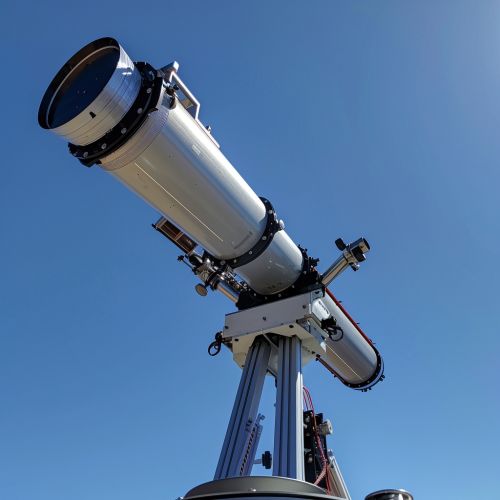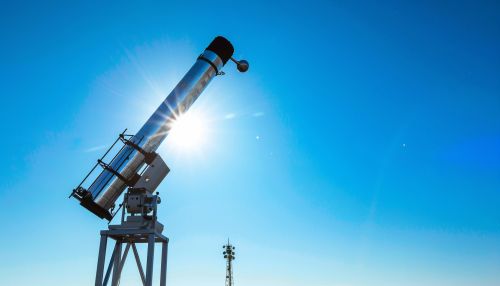Solar Telescope: Difference between revisions
(Created page with "== Overview == A '''solar telescope''' is a specialized type of telescope used to observe the Sun. Unlike conventional telescopes designed for night-time astronomy, solar telescopes are engineered to handle the intense light and heat emitted by the Sun. These instruments are crucial for studying solar phenomena such as sunspots, solar flares, prominences, and the solar corona. Solar telescopes have contributed significantly to our understanding of solar physics and the...") |
No edit summary |
||
| Line 17: | Line 17: | ||
* The [[Swedish 1-m Solar Telescope|Swedish 1-m Solar Telescope (SST)]] in the Canary Islands. | * The [[Swedish 1-m Solar Telescope|Swedish 1-m Solar Telescope (SST)]] in the Canary Islands. | ||
[[Image:Detail-91703.jpg|thumb|center|High-resolution image of a solar telescope at an observatory, with a clear blue sky in the background.|class=only_on_mobile]] | |||
[[Image:Detail-91704.jpg|thumb|center|High-resolution image of a solar telescope at an observatory, with a clear blue sky in the background.|class=only_on_desktop]] | |||
=== Space-Based Solar Telescopes === | === Space-Based Solar Telescopes === | ||
Latest revision as of 01:22, 20 June 2024
Overview
A solar telescope is a specialized type of telescope used to observe the Sun. Unlike conventional telescopes designed for night-time astronomy, solar telescopes are engineered to handle the intense light and heat emitted by the Sun. These instruments are crucial for studying solar phenomena such as sunspots, solar flares, prominences, and the solar corona. Solar telescopes have contributed significantly to our understanding of solar physics and the Sun's impact on the heliosphere and space weather.
History
The history of solar telescopes dates back to the early 17th century when Galileo and Kepler made some of the first solar observations using simple refracting telescopes. However, it was not until the 19th century that more sophisticated solar telescopes were developed. The advent of the spectroscope allowed astronomers to analyze the Sun's light in greater detail, leading to the discovery of helium and other elements in the solar spectrum.
Types of Solar Telescopes
Ground-Based Solar Telescopes
Ground-based solar telescopes are typically located at high altitudes to minimize the effects of the Earth's atmosphere. These telescopes often use adaptive optics to correct for atmospheric distortions. Notable ground-based solar telescopes include:
- The Big Bear Solar Observatory (BBSO) in California.
- The McMath-Pierce Solar Telescope in Arizona.
- The Swedish 1-m Solar Telescope (SST) in the Canary Islands.


Space-Based Solar Telescopes
Space-based solar telescopes avoid atmospheric interference altogether, providing clearer and more detailed observations. Some of the most important space-based solar observatories include:
- The Solar and Heliospheric Observatory (SOHO).
- The Solar Dynamics Observatory (SDO).
- The Parker Solar Probe.
Components and Design
Solar telescopes are designed with several key components to handle the Sun's intense light and heat:
Objective Lens or Mirror
The objective lens or mirror collects and focuses sunlight. In solar telescopes, these components are often made from materials that can withstand high temperatures.
Filters
Solar telescopes use a variety of filters to reduce the Sun's brightness and isolate specific wavelengths of light. Common filters include:
- Hydrogen-alpha (H-alpha) filters, which isolate the red light emitted by hydrogen atoms.
- Calcium-K (Ca-K) filters, which isolate the violet light emitted by ionized calcium.
Detectors
Modern solar telescopes use advanced detectors such as charge-coupled devices (CCDs) and photomultiplier tubes to capture high-resolution images and spectra.
Scientific Contributions
Solar telescopes have made numerous contributions to our understanding of the Sun and its behavior. Key discoveries include:
- The detailed structure of sunspots and their magnetic fields.
- The dynamics of solar flares and their impact on space weather.
- The properties of the solar corona and its role in the solar wind.
Challenges and Future Developments
Observing the Sun presents unique challenges, including managing the intense heat and light. Future developments in solar telescope technology aim to overcome these challenges and provide even more detailed observations. Upcoming projects include the Daniel K. Inouye Solar Telescope (DKIST) and the European Solar Telescope (EST).
See Also
- Heliosphere
- Spectroscope
- Helium
- Big Bear Solar Observatory
- McMath-Pierce Solar Telescope
- Swedish 1-m Solar Telescope
- Solar and Heliospheric Observatory
- Solar Dynamics Observatory
- Parker Solar Probe
- Hydrogen-alpha
- Calcium-K
- Charge-Coupled Device
- Photomultiplier Tube
- Sunspot
- Solar Flare
- Solar Corona
- Daniel K. Inouye Solar Telescope
- European Solar Telescope
